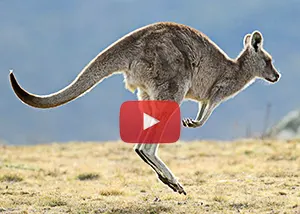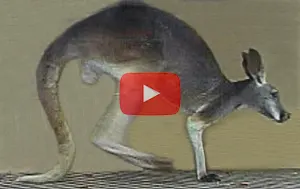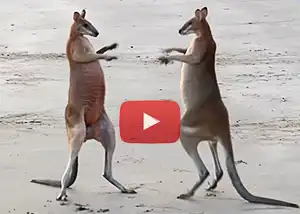Wallabies: Agile Hopping Marsupials
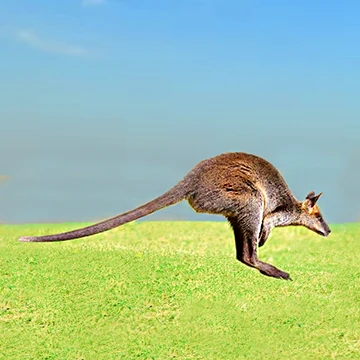
Photo: Wallaby hopping through the Australian outback
Contents
What is a Wallaby?
Wallabies are small, agile herbivorous marsupial macropods with upright postures, powerful disproportionately large hind legs, small forelimbs, long thick tails and large ears. They are closely related to kangaroos, but are much smaller. Wallabies typically weigh between 1 to 20 kg and range in size from 30 cm to 1.8 meters head to tail. Wallabies move by using their powerful hind legs for hopping. They have excellent vision comparable to rabbits, cattle, or horses. Wallabies, are classified by habitat—such as rock wallabies, bush wallabies, and shrub wallabies—or by size and appearance, like the hare wallaby.
Key Differences Between Wallaby and Kangaroo
Wallabies are closely related to kangaroos but have the following differences.
| Feature | Wallaby | Kangaroo |
|---|---|---|
| Size | Smaller | Larger |
| Habitat | Forest, Rocky Outcrops | Open Plains |
| Colouration | Brighter patterns | Typically uniform |
| Diet | Leaves, grasses, herbs | Grasses primarily |
How Do Wallabies Hop?
Wallabies use hopping as its primary mode of locomotion. Their long hind legs and massive Achilles tendons work like springs, similar to how a Pogo Stick works, allowing them to move swiftly and efficiently.
• Wallabies increase speed by increasing the length of their hops.
• Top Speed: A large wallaby can reach a top speed of 48 km/h.
• Movement style: Hops using both hind legs; pivots sharply for quick escapes.
• Cannot hop at very low speeds,
so it uses its tail as an extra leg and its arms in a five-limbed walk called pentapedaling locomotion. (See next section to learn how pentapedaling works).
Wallaby's Extra Leg - Pentapedaling
A wallaby moves at low speeds by using its tail as an extra leg! Leaning forward onto its short front limbs, hoisting itself up with its tail, and then shifting its hind legs forward. This method of movement is called 'pentapedal' (four limbs + tail) locomotion. The wallaby's tail, with its 20 vertebrae, acts like a fifth limb, fulfilling the role of a normal leg. In this role, it can generate more forward force than all of its other limbs combined.
The Wallaby's Versatile Tail
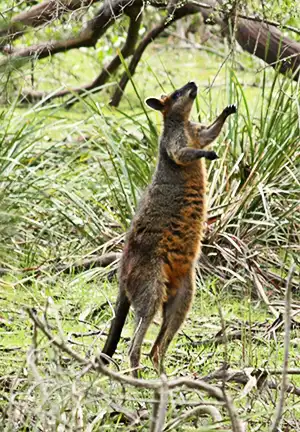
Photo: Wallaby using its tail as a tripod
Wallabies have a very versatile tail. They use their tail as:
• A tripod when standing on their hind legs.
• For balance while hopping, and as a store for excess fat.
• As a fifty leg when moving slowly (pentapedaling).
• Stores fat as a food reserve.
Wallaby Communication & Social Behaviour
Wallabies are mostly quiet solitary animals, and use a few verbal and non-verbal cues to communicate:
• Foot Thumping with one or both feet to alert other wallabies of danger or as a warning to a predator to stay away.
• Mothers make gentle clicking noises to communicate with their young.
• A threatened wallaby may hiss or growl to indicate danger.
• When displaying aggression, a wallaby emits a sharp "ha" sound.
• During courtship, males create a soft chuckling noise.
Where Do Wallabies Live?
Wallabies inhabit diverse habitats throughout Australia and New Guinea where there vegetative cover and reliable water sources.
• Rock wallabies live in boulder-strewn areas with subterranean holes and passageways, cliffs with ledges and caves, and isolated rock stacks.
• Agile wallabies prefer dry open woodland, heaths, dunes, and grassland in northern Australia and New Guinea.
Wallaby Diet & Digestion
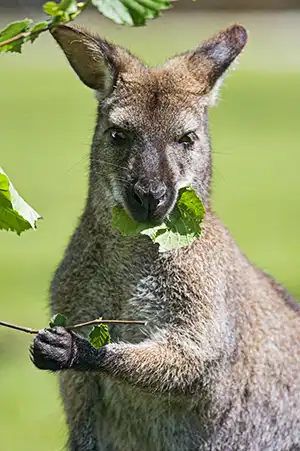
Photo: Wallaby eating leaves
• Wallabies are herbivores. They eat leaves, but they also consume flowers, ferns, moss, and occasionally they even eat insects.
• They tend to feed at night, and in the early morning and late evening in cooler weather. During the day, they rest in the shade.
• Wallabies have a chambered stomach similar to that of a horse, that helps it digest fibrous plant material efficiently.
• They regurgitates its food to chew it again and then swallows it, a process known as chewing the cud. This extra step aids in breaking down the rough fibres of their diet and improves digestion.
• Wallabies require very little water. They need only needs about 13% of the water that a sheep needs and can survive for months without drinking water.
Wallabies Do Eco-friendly Farts
Wallabies have an environmentally friendly digestive system that converts hydrogen by-products into acetate, a compound that is then absorbed and used as an energy source. As a result, wallabies produce eco-friendly farts, emitting CO2 instead of methane—making them environmentally-friendly grazers.
Wallaby Reproduction & Life Cycle
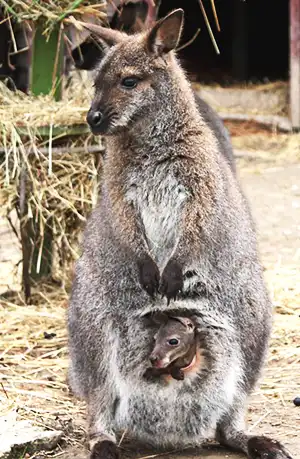
Photo: Wallaby female with a joey in its pouch
The female wallaby has an abdominal pouch in which she raises her young. A baby wallaby is no larger than a jelly-bean (2cm) and weighs as little as one gram when it is born. The reason for this is because wallabies belong to a group of animals known as marsupials. Marsupial babies have two stages of development. One inside the mother like placental mammals such as humans and the other outside the mother’s body in a special external pouch called a marsupium.
Stage 1 – A wallaby joey is born approximately 30 days after gestation. No larger than a jelly-bean (2 cm), it emerges from its mother’s birth canal blind, hairless, with stumpy forelimb and hardly any trace of its hind legs. Using its little forelimbs in a swimming (breaststroke) motion, the young joey crawls laboriously up its mother's fur to the pouch. This journey takes it about three minutes. The joey's journey is made entirely by itself. The mother does not assist it in any way.
Stage 2 – Once inside its mother's pouch, the joey quickly attaches itself firmly to one of four nipples in the pouch. Once it has attached itself to its mother's nipple, the young joey will stay hidden for up to six and a half months. Then it will start to tentatively pop its head out of its mother's pouch and observe the world around it. About two weeks later, it will have gained enough confidence to venture out of the pouch and hop about close to its mother. However, if frightened, it will immediately jump back into the safety of the pouch. By the time it is about 8 months old, the joey no longer uses its mother's pouch.
Depending on the type of wallaby, it may have a lifespan of between 2 and 11 years.
Wallabies Fighting
Wallabies fight less than most other types of herbivores. A male wallaby fights by standing on its hind legs and hitting with its front paws (which have sharp claws). Or by kicking its opponent with its powerful hind legs while balancing itself on its tail. These fights usually occur over mating rights and are more ritualistic than aggressive. Very rarely do wallabies hurt each other during fights. Contrary to popular folklore, a wallaby doesn't box like humans do.
Wallabies Can Swim
Wallabies usually live in relatively dry areas with few large bodies of water. Oddly, however, they are very confident in water and are good swimmers. There are reports of numerous sightings of wallabies swimming far out at sea.
The wallaby swims by 'dog-paddling' with all four limbs. While it moves its rear legs in unison when it hops, while swimming its moves them independently.
Are Wallabies Nocturnal?
Wallabies are classified as being nocturnal animals. That is, they are active mainly at night. However, this is not entirely correct. Wallabies are primarily crepuscular. That is, that they are most active around dawn and dusk, and this activity can continue into the night. Wallabies usually rest during the day, but it is not uncommon the see a mob of wallabies moving through the countryside during the daytime.
Wallaby Predators & Threats
The only native predator of adult wallabies is the Tasmanian Devil. Baby wallabies, however, fall victim to goannas — native monitor lizards, snakes and wedge-tailed eagles. Several introduced animals such as dingoes, European red foxes, feral cats and dogs also attack wallabies.
Since the arrival of European settlers in 1778, humans have had a more considerable effect on on wallaby populations due to farming, grazing, land clearing and forest felling. While some wallaby species have been impacted and may even become extinct, the overall wallaby population does not seem to have been seriously affected by these activities.
One of the most significant impacts of humans are road kills.
Are Wallabies Endangered?
Certain species of the rock wallaby, are considered to be endangered. Most other wallaby species are quite prolific and are not threatened.
25 Wallaby Facts
- Wallabies are small to medium-sized hopping marsupials.
- They are similar in appearance to kangaroos but are smaller and live in forested areas.
- There are 30 types of wallabies.
- Wallabies weigh between 1-20 kilos.
- A large wallaby can cruise at 25 kph and reach a maximum speed of 48 kph.
- A male wallaby is called a Jack. A female is called a Jill. A baby wallaby is called a Joey.
- Most wallaby species are named according to where they live.
- A wallaby's eyesight is comparable with that of rabbits, cattle or horses.
- A wallaby replaces its teeth throughout its life. New teeth grow at the back and move forward to replace those in the front.
- To keep cool, the wallaby covers its forearms with saliva. The evaporating saliva helps cool its body.
- Wallabies have almost non-existence vocal cords and communicate by clicking and foot thumping.
- A wallaby has five legs! That’s if you include its tail which it uses like a leg at slow speeds.
- It also uses its tail like a tripod to prevent itself from toppling backwards.
- When hopping, its tail counterbalances its body, preventing it from falling forward.
- The wallaby cannot move backwards.
- A large wallaby can jump as high as three meters.
- Wallabies eat leaves, flowers, ferns, moss and even insects.
- They are active mostly at night.
- Wallabies do eco-friendly farts with almost no methane (Ch4) gas.
- A wallaby gets most of its moisture from its food. As a result, it can survive for months without drinking water.
- A wallaby requires only 13% of the water needed by a similar-sized sheep.
- A baby wallaby is no larger than a jelly-bean when born.
- The female wallaby raises its baby in a pouch outside its body and feeds it milk.
- Wallabies live for 6 to 15 years.
- Wallabies are quite common. The rock wallaby, however, is endangered.
